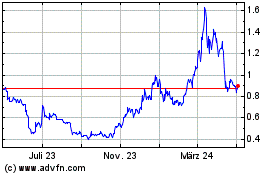Gas Crisis Averted: NFT Marketplaces Witness Dramatic Reduction in Ethereum Fees
19 Mai 2023 - 10:50PM
NEWSBTC
Ethereum gas consumption landscape is transforming significantly as
Non-Fungible Token (NFT) marketplaces no longer dominate the
network’s gas usage. According to a report by Nansen, a crypto
analytics platform, NFTs have fallen behind in doing the most in
Ethereum gas fees. Notably, while Ethereum’s transition to
proof-of-stake, in an event known as “The Merge,” is anticipated to
address high gas prices, investors are now exploring alternatives
like Cardano, which boasts greater cost-efficiency following its
recent Hydra upgrade. Ethereum’s Gas Consumption Shift According to
data revealed by Nansen on Friday, there’s currently a noteworthy
shift in Ethereum’s gas consumption patterns. NFT marketplaces,
which once held the top spot, now account for a mere 3% of total
gas usage. Related Reading: Crypto Assets Flow From Ethereum To
BSC, Are Users Escaping High Gas Fees? Surprisingly, decentralized
exchange (DEX) Uniswap has emerged as the primary gas consumer,
representing 31.99% of gas consumption. This shift indicates a
diversification in Ethereum’s transactional activity and a
reduction in NFT-related gas usage. Nansen noted: Gone were the
days of NFTs topping the Ethereum gas-consuming charts. This week,
of the top 20 gas consumers, OpenSea and Blur accounted for less
than 10% combined. And against all gas consumers, the NFT
marketplaces were just over 3%. Uniswap in contrast was 10x more –
31.99%. This substantial decline in NFT-related gas consumption can
be attributed to various factors, including the network’s
congestion caused by an influx of meme coin trading, notably the
recently hyped frog-themed meme coin PEPE. This surge in meme coin
transactions resulted in heightened gas prices, prompting users to
explore alternatives and alleviating the burden on NFT
marketplaces. Navigating the Gas Crisis Ethereum‘s gas crisis has
persisted despite The Merge, which is said to enhance scalability
and reduce gas fees by migrating the network to a proof-of-stake
consensus model. In response, some investors have sought solace in
blockchain platforms offering cost-efficient alternatives. With its
recent Hydra upgrade, Cardano has gained attention for its ability
to handle transactions more economically. The implementation of
Hydra’s layer-2 scaling solution has positioned Cardano as a viable
option for users seeking relief from Ethereum’s high gas prices.
The recent decrease in NFT marketplaces’ gas consumption marks a
significant turning point in Ethereum’s gas crisis. As
decentralized finance (DeFi) protocols and other transaction-heavy
platforms take the lead in gas consumption, the burden on NFT
marketplaces has lessened. Related Reading: Ethereum Price Faces
Confluence Of Bearish Factors and At Risk of Another Decline
However, the broader Ethereum community anticipates the
implementation of updates on the mainnet to address the persistent
gas issues and improve scalability on the network. Meanwhile,
Ethereum’s price has experienced an upward trend in the past week,
up by 2.4%. ETH has surged from a low of $1,771 seen last Friday to
trading as high as above $1,800 later this week. Ethereum
market capitalization has also recorded huge gains in the past 7
days. ETH’s market cap has surged over 2% from a cap low of $215
billion to a high of $218 billion on Friday. Meanwhile, ETH’s daily
trading volume has plunged throughout the week from a high of $10
billion last Friday to $5.5 billion in the last 24 hours.
Interestingly, the asset has picked up from where it left off,
rallying 1.1% in the last 24 hours. ETH currently trades slightly
above $1,800 with a price of $1,811 at the time of writing.
Featured image from Unsplash, Chart from TradingView
Flow (COIN:FLOWUSD)
Historical Stock Chart
Von Mär 2024 bis Apr 2024

Flow (COIN:FLOWUSD)
Historical Stock Chart
Von Apr 2023 bis Apr 2024
